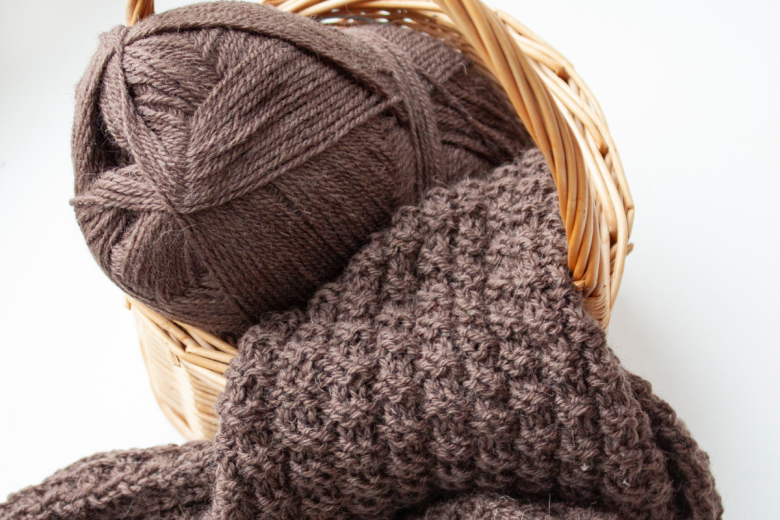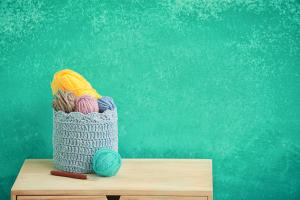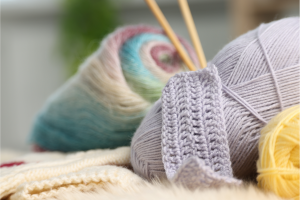Knitting is a timeless craft that combines creativity, relaxation, and practicality. For beginners, it can seem daunting to pick up needles and yarn, but starting with the right project can make all the difference. A scarf is the perfect choice for your first knitting endeavor. Why? It’s simple, versatile, and forgiving, making it an ideal project to practice and refine your skills without feeling overwhelmed.
Unlike complex patterns that require advanced techniques, a scarf allows you to focus on mastering the basics, such as casting on, creating knit stitches, and binding off. Additionally, the repetitive nature of knitting a scarf provides ample opportunity to develop muscle memory, ensuring your stitches become smoother and more consistent over time.
Beyond its simplicity, knitting a scarf offers an immediate sense of accomplishment. As you watch your creation grow row by row, you’ll feel the satisfaction of turning raw materials into something both beautiful and functional. Whether you’re making it as a gift for someone special or for your own wardrobe, your first scarf will be a tangible reminder of your entry into the world of knitting.
In this guide, you’ll learn everything you need to confidently knit your first scarf, from selecting materials to adding the finishing touches. Let’s get started and turn your beginner aspirations into a handcrafted masterpiece!
Knitting isn’t just about creating something functional; it’s also a deeply rewarding experience that fosters creativity and relaxation. As you dive into this craft, you’ll find that the rhythmic motion of the needles and the soft texture of the yarn can be incredibly calming. It’s a skill that allows you to slow down, focus, and enjoy the process as much as the finished product. With your first scarf, you’ll get a taste of how knitting can become a cherished hobby that provides both a creative outlet and a sense of accomplishment.
Starting with a scarf is ideal because it provides the perfect canvas for practicing basic techniques. Unlike more intricate projects, a scarf doesn’t require complex patterns or shaping, which allows you to build confidence in your stitches at your own pace. Plus, a scarf is a timeless and practical accessory that you can wear proudly or gift to a loved one. It’s an excellent way to make your learning journey both meaningful and productive.
One of the most exciting aspects of knitting is the ability to personalize your work. With countless yarn colors, textures, and types to choose from, you can craft a scarf that reflects your unique taste. Whether you prefer bold and vibrant hues or soft, neutral tones, the choices are endless. Your scarf will not only showcase your creativity but also serve as a testament to your growing skills as a knitter.
As you progress through this guide, remember that mistakes are a natural part of learning. Every dropped stitch or uneven row is a stepping stone to improvement, and with practice, your confidence will grow. By the time you finish your first scarf, you’ll have gained a strong foundation in knitting and the motivation to tackle more advanced projects. Let’s take that first step together and bring your creative vision to life!
Understanding the Basics of Knitting
What You’ll Need: Essential Knitting Tools and Materials
Before you begin, gather the essential tools:
- Knitting Needles: Start with medium-sized needles (US size 8–10, or 5–6mm), as they are easier to handle for beginners.
- Yarn: Choose a worsted-weight yarn, which is versatile and easy to work with.
- Scissors: You’ll need a small, sharp pair to cut your yarn.
- Tapestry Needle: Use this for weaving in loose ends once your scarf is complete.
- Measuring Tape: Helps ensure you maintain the desired length and width.
- Row Counter (optional): Useful for keeping track of your progress.
Yarn Selection: Choosing the Right Yarn for Your First Scarf
The right yarn can make your first project much smoother. For beginners:
- Material: Acrylic yarn is budget-friendly and easy to work with. Wool adds warmth and elasticity but may require special care.
- Color: Opt for lighter colors, as they make it easier to see your stitches.
- Texture: Smooth yarn is best for beginners, avoiding anything too fuzzy or textured, as it can be challenging to identify stitches.
Knitting Terminology: Key Terms to Know Before You Start
Familiarize yourself with these essential terms:
- Cast On: The process of creating the initial stitches on your needle.
- Knit Stitch: The basic stitch used in most beginner projects.
- Bind Off: How you secure the final row of stitches to finish your piece.
- Gauge: Refers to the number of stitches and rows per inch, affecting the size of your project.
Getting Started with Knitting
Casting On: The Foundation of Every Knitting Project
Casting on is your first step. The two most beginner-friendly methods are:
- Long-Tail Cast-On: Creates a stretchy foundation ideal for scarves.
- Simple Cast-On: Easier for absolute beginners but less flexible.
Learning the Knit Stitch: The Building Block of Your Scarf
The knit stitch is fundamental. Hold the needle with cast-on stitches in your left hand, insert the right needle into the first stitch, loop the yarn over, and pull through to transfer it to the right needle. Repeat across the row.
Understanding Gauge and Tension: Why They Matter
Gauge determines the scarf’s dimensions, while tension affects stitch consistency. Practice knitting a swatch to ensure your scarf doesn’t turn out too loose or tight.
Knitting Your First Rows
Maintaining Consistency: Tips for Even Stitches
- Keep your yarn tension consistent throughout the row.
- Check your stitches regularly to avoid accidental increases or decreases.
Troubleshooting Common Beginner Mistakes
- Dropped Stitches: Use a crochet hook to pick up a dropped stitch.
- Tight Stitches: Loosen your grip on the yarn for smoother movement.
Adding Finishing Touches
Binding Off: How to End Your Knitting Project
To bind off, knit two stitches, then pass the first stitch over the second and off the needle. Repeat until only one stitch remains, then cut the yarn and pull it through the final loop.
Weaving in Loose Ends for a Polished Look
Thread a tapestry needle with the loose ends and weave them into the nearest stitches on the back of your scarf to secure them.
Optional: Adding Fringe or Decorative Elements
Cut equal lengths of yarn, fold them in half, and loop them through the ends of your scarf to add a playful fringe.
Caring for Your Finished Scarf
Washing and Storing Your Handmade Creation
Check the yarn label for care instructions. Handwashing with gentle detergent is typically safest for handmade scarves. Lay it flat to dry to maintain its shape.
Styling Tips: How to Wear Your New Scarf
Experiment with different draping styles, such as looping it around your neck or letting it hang freely for a cozy, stylish look.
Celebrating Your Achievement: What’s Next on Your Knitting Journey
Congratulations on completing your first knitted scarf! Not only have you mastered the foundational techniques of knitting, but you’ve also created something unique and meaningful with your own hands. This is a major milestone in your knitting journey, and it’s worth celebrating. Whether your scarf becomes a treasured accessory, a heartfelt gift, or a keepsake of your new skill, it’s a testament to your creativity and dedication.
Now that you’ve conquered the basics, the world of knitting is wide open for exploration. Consider trying out new projects that challenge your growing skills, such as hats, mittens, or even a simple blanket. Experiment with different yarns, colors, and textures to discover your personal knitting style. Don’t forget to delve into new techniques like purl stitches, ribbing, or even simple patterns to add variety to your projects.
Knitting is more than just a hobby; it’s a relaxing and meditative craft that offers endless opportunities for creativity and self-expression. Along the way, you’ll join a vibrant community of fellow knitters who share tips, patterns, and encouragement.
So, what’s next on your knitting journey? Maybe it’s learning to knit in the round, experimenting with colorwork, or creating your first wearable garment. Whatever you choose, each project will build on the skills you’ve learned and bring new excitement to your knitting adventures.
Remember, every expert knitter started where you are now—with a simple scarf and a desire to create. Keep practicing, stay curious, and enjoy every stitch of the journey ahead.
The beauty of knitting lies not only in the tangible items you create but also in the intangible rewards it brings. Each stitch you’ve crafted in your first scarf represents patience, focus, and a willingness to learn—qualities that will serve you well as you continue exploring this timeless art. Your scarf is more than just a piece of fabric; it’s a symbol of your journey, filled with the story of your first foray into the world of knitting.
As you celebrate this milestone, take a moment to reflect on how far you’ve come. The initial confusion over knitting terminology, the challenge of casting on, and the trial-and-error moments that led to dropped stitches—all of these experiences have shaped your understanding of the craft. The perseverance you’ve demonstrated is a testament to your ability to learn something new, even when it seemed daunting at first.
Knitting is a skill with endless possibilities. From creating cozy winter accessories to intricate home décor, your newfound ability opens the door to a lifetime of creativity. As you explore more projects, you’ll gain not only technical expertise but also an appreciation for the artistry involved. Each new pattern you try will bring its own set of lessons and rewards, helping you grow as both a crafter and an artist.
Don’t forget to take pride in the connections knitting fosters. Whether you knit alone as a form of meditation or share your progress with friends and family, this craft brings people together. You might find yourself joining a knitting circle, attending workshops, or simply bonding with someone over shared tips and patterns. These connections add another layer of richness to the craft, turning it into a shared journey rather than a solitary endeavor.
The road ahead is filled with endless opportunities to create, learn, and inspire. From here, the only limit is your imagination. So, embrace this accomplishment and look forward to the exciting projects yet to come. Knitting isn’t just something you do; it’s a skill that becomes a part of who you are. Welcome to the wonderful world of knitting!




